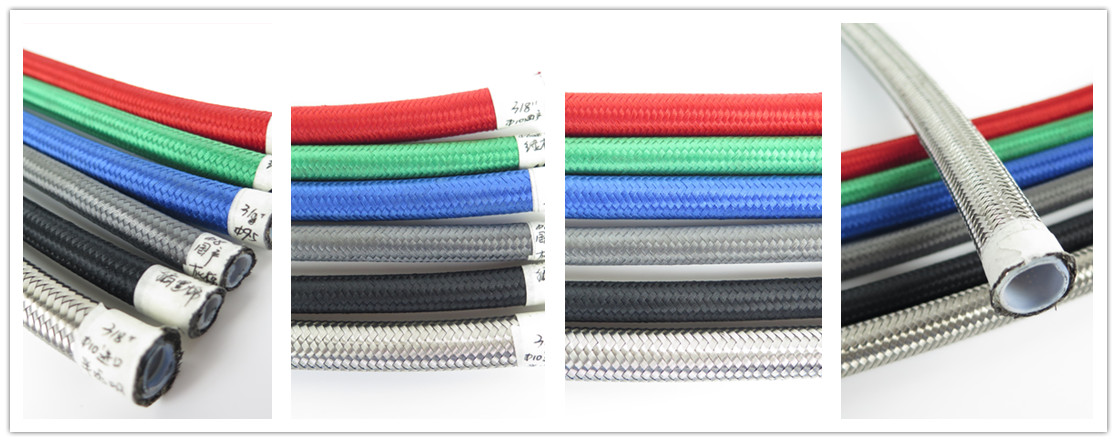The rubber hose was introduced to everyone before. Today I will give you a different product. Its material is not rubber--PTFE hose. This kind of hose is also in great demand in the market. It is used in various fields. Let me know this product with me.

International standard: SAE 100 R14
Conventional specifications: 1/8"-2"
1.structure:
Inner tube: PTFE straight tube or PTFE bellows
PTFE bellows: It is made by special blow molding. It is made by heating the PTFE tube to a certain temperature in a certain mold, giving a certain internal pressure in the tube to expand (inflate) the tube laterally, and then cooling and shaping. Bellows has the inherent properties of PTFE, and also has high flexibility and elasticity, but the pressure is lower than that of PTFE straight pipes.
2.Braided layer: composed of ASI304 or 316 stainless steel wire3.In order to meet other needs, some customers may also coat a layer of stainless steel wire braided with materials including but not limited to PU, PVC, glass fiber, TPU, POF, silicone, polyester, various colors of cotton yarn (thread)、Aramid, etc.
●Protection of stainless steel braid, suitable for automotive brake tubes
●(glass fiber)-insulation (thermal insulation)
● (Thermoplastic polyurethane elastomer rubber)-beneficial protection of stainless steel braid
● (silica gel)-thermal insulation and wear resistance
●(Polyester)-thermal insulation
●(cotton yarn)-thermal insulation
●(Color cotton yarn)-insulation
●(Aramid)-thermal insulation and enhanced working pressure
PTFE Hose performance characteristics:
1.Physical and mechanical properties: PTFE has a relatively high density and hardly absorbs water. Tough and non-resilient. Has a very small friction factor, showing excellent lubricity. The static friction factor of PTFE is smaller than the dynamic friction factor, and from ultra-low temperature to melting point, the friction factor remains almost unchanged. However, PTFE has low hardness and is easily worn by other materials. If a layer of PTFE film can be formed on the surface of the grinding material, the amount of PTFE wear can be reduced to a considerable extent.
2. Thermal performance: The thermal stability of PTFE is extremely prominent among the engineering plastics. From 200 ℃ to the melting point, its decomposition rate is extremely slow, and the amount of decomposition is also very small. Heating at 200 ℃ for one month, the decomposition amount is less than 1 part per million, which can be ignored. PTFE is still not brittle at -250℃. Can be used for a long time at -250~260℃.
3. Electrical properties: PTFE is a highly non-polar material with extremely excellent dielectric properties. When it is prominently above 0℃, the dielectric properties are not affected by frequency and temperature, nor are they affected by humidity and corrosive gases . The volume resistivity and surface resistivity of PTFE are the highest among all engineering plastics. Even if they are immersed in water for a long time, they will not drop significantly. In 100% relative humidity air, the surface resistivity remains unchanged. When the crystallinity of PTFE is between 50% and 80%, the dielectric strength is almost independent of the crystallinity and has the lowest dielectric constant. PTFE has excellent arc resistance.
4. Chemical resistance: PTFE has extremely excellent chemical stability and is almost not attacked by any chemical substances. Many highly corrosive and strong oxidizing chemicals have almost no effect on it, so it is called the king of plastics. . Only the alkali metal in the molten state can take off the fluorine atoms in PTFE and discolor the surface.
5. Other properties: PTFE's atmospheric aging resistance is very outstanding, even if exposed to the atmosphere for a long time, the surface will not produce any changes. The flame retardancy of PTFE is also very outstanding, its oxygen index is as high as 95%, ranking first, and the flame retardancy reaches UL94 V-0 level. Non-stickiness is another important characteristic of PTFE. Almost all solid materials cannot adhere to its surface. But the effect of high-energy rays on it is obvious.
Due to the defects in corrosion resistance of rubber, glass, metal alloys and other materials, it is difficult to meet the harsh environment where temperature, pressure and chemical media coexist, and the resulting loss is quite alarming. The PTFE material can meet these requirements, so it can be widely used in chemical industry, petroleum, textile, electronic and electrical, medical, machinery and so on.Its specific applications include: conveying pipes for conveying corrosive gases, exhaust pipes, steam pipes, high-pressure oil pipes for rolling mills, high, medium and low pressure pipes for aircraft hydraulic systems and cold pressure systems.
Through the above introduction, I believe everyone has a certain understanding of Teflon tubes. If you need it, please consult our sales staff, or want to discuss more technical knowledge, you can also contact our technical staff, we will see you next time!
Contact us
Alice Kuang
TEL:15603187125QQ:517026401
E mail:alice@chnhose.com